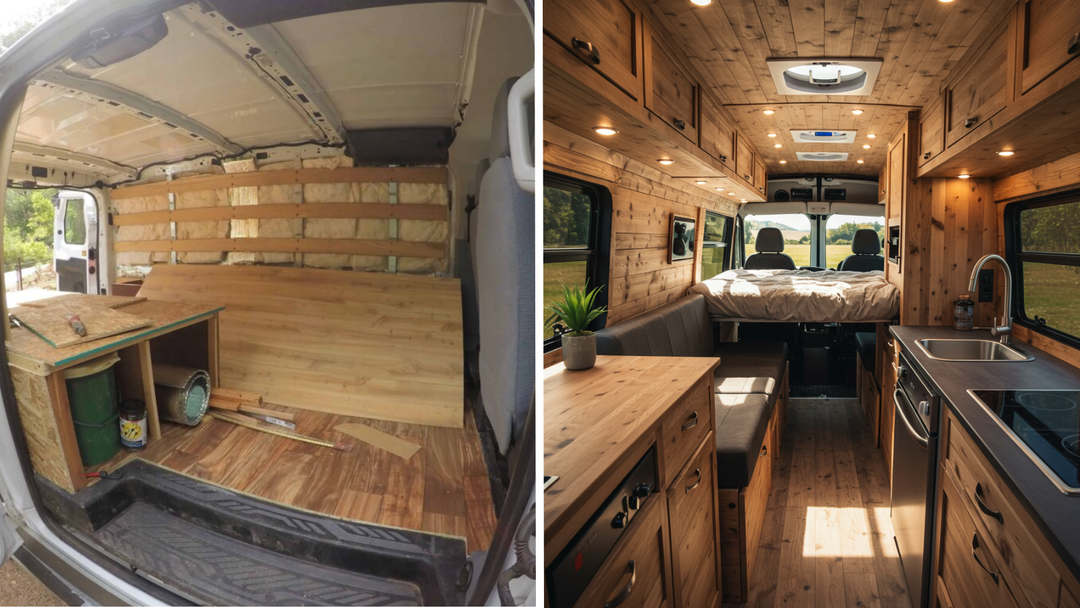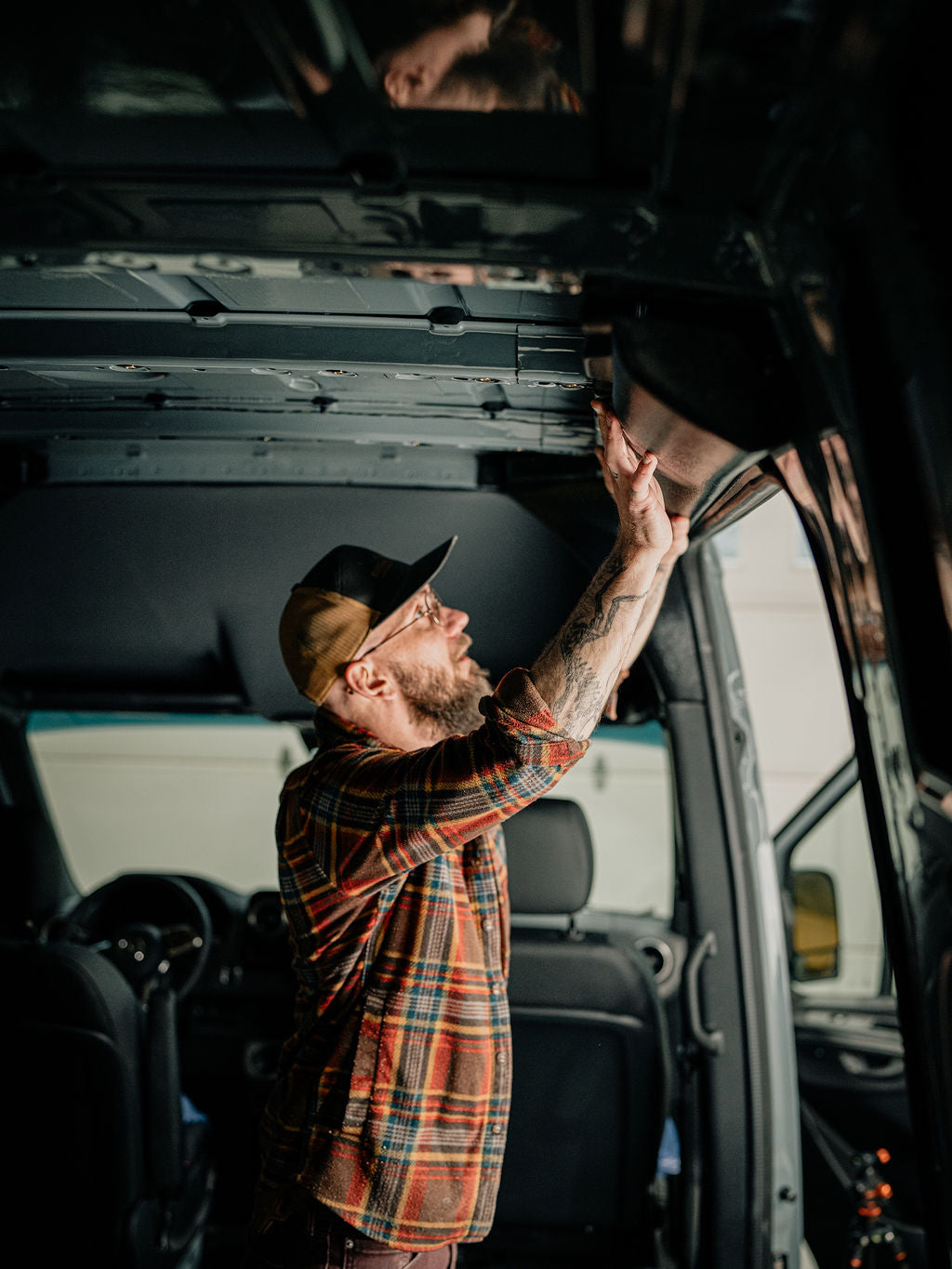What’s the Best Way to Sleep in a Van? A Builder’s Guide to Smart Bed Layouts
Not All Van Beds Are Created Equal
Some steal your space. Some eat your storage. And some just flat-out don’t work for tall people.
We’ve built vans professionally for years, and the one question we hear most often: “What’s the best way to sleep in here?” The answer? It depends—but if you want to save space, sleep well, and make your van actually feel like a home, there’s one layout that stands out.
This guide walks you through the pros and cons of all major van bed setups—and why sideways sleeping has become the go-to layout for builders who care about comfort and space.
Common Van Bed Layouts
1. Lengthwise (North-South) Sleeping
Overview: This traditional setup places the bed along the length of the van, allowing sleepers to lie from front to back.

Pros:
-
Accommodates taller individuals without modifications.
-
No need for structural changes to the van's sidewalls.
Cons:
-
Occupies significant floor space, limiting room for other amenities.
-
May require climbing over a partner to get in or out of bed.
2. Sideways (East-West) Sleeping
Overview: The bed is oriented across the width of the van, from side to side.

Pros:
-
Saves valuable floor space, providing more room for storage or living areas.
-
Allows for a more open and spacious interior layout.
Cons:
-
May be too short for taller individuals unless modifications are made.
-
Requires careful planning to ensure sufficient width for comfortable sleeping.
3. Convertible Beds (Dinette or Sofa Beds)
Overview: These multifunctional setups transform from seating areas into beds.

Pros:
-
Maximizes space by serving dual purposes.
-
Ideal for daytime use and entertaining.
Cons:
-
Daily setup and takedown can be cumbersome.
-
May not offer the same comfort level as a fixed bed.
4. Elevated Beds with Garage Storage
Overview: A fixed bed platform raised to create storage space underneath.

Pros:
-
Provides ample storage for gear and equipment.
-
Keeps the sleeping area separate from the living space.
Cons:
-
Reduces headroom in the sleeping area.
-
May require a higher roof van to accommodate.
5. Pop-Top Roof Beds
Overview: An expandable roof section that houses a bed, often found in campervans.

Pros:
-
Adds an extra sleeping area without occupying floor space.
-
Offers panoramic views and ventilation.
Cons:
-
Less insulation, potentially leading to temperature control issues.
-
May not be suitable for all climates or stealth camping.
Quick Comparison: Van Bed Layouts at a Glance
|
Bed Type |
Best For |
Space Efficiency |
Comfort |
Build Difficulty |
|
Lengthwise |
Tall sleepers, minimal mods |
Low |
High |
Low |
|
Sideways |
Space-conscious builds |
High |
High (with mods) |
Medium |
|
Convertible |
Multi-use layouts |
Medium |
Medium |
High |
|
Elevated |
Gear-heavy travelers |
Medium |
High |
Medium |
|
Pop-Top |
2nd bed, scenic camping |
Very High |
Medium |
High |
Builder Insight 💡
If there’s one thing we’ve learned after dozens of builds, it’s this: space is everything. The more space you save on your bed layout, the more freedom you get everywhere else. That’s why we’re big on sideways sleeping—it’s one of the smartest layout decisions you can make.
The Case for Sideways Sleeping
For van builders and DIY enthusiasts aiming to optimize space, sideways sleeping presents a compelling option. By orienting the bed across the van's width, you can reclaim up to 12 inches of floor space, which can be repurposed for a kitchen, workspace, or additional storage.
However, the standard interior width of many vans may not suffice for comfortable sideways sleeping, especially for taller individuals. This challenge can be addressed by installing sleeping capsules or flares, which extend the van's width at bed height, providing the necessary space for a restful sleep.
Enhancing Sideways Sleeping with Innie Sleepers
To facilitate sideways sleeping without extensive modifications, consider using products like the Transit Innie Sleepers. These ABS plastic capsules are designed to fit seamlessly into the van's window cavities, offering additional width without protruding beyond the vehicle's exterior. This approach maintains the van's sleek profile while enhancing interior space.

For those working with Mercedes Sprinter vans, Flare Trim Rings can be used in conjunction with flares to create a clean, finished look and maximize the usable space within the sleeping area.

Conclusion
Selecting the best sleeping arrangement in your van conversion depends on your specific needs, preferences, and the van's dimensions. While lengthwise beds are straightforward, they consume more space. Convertible beds offer flexibility but may compromise on comfort. Sideways sleeping, especially when enhanced with solutions like Innie Sleepers or flares, provides a balance between space efficiency and comfort.
As professional van builders, we've seen firsthand how thoughtful design choices can transform a cramped van into a comfortable, functional living space. Prioritize your comfort and consider how each sleeping arrangement aligns with your lifestyle and travel goals.
✅ Want to learn more about how capsules can transform your build? Check out our full guide: Sleeping Capsules for Vans.
- The GoCode Team





